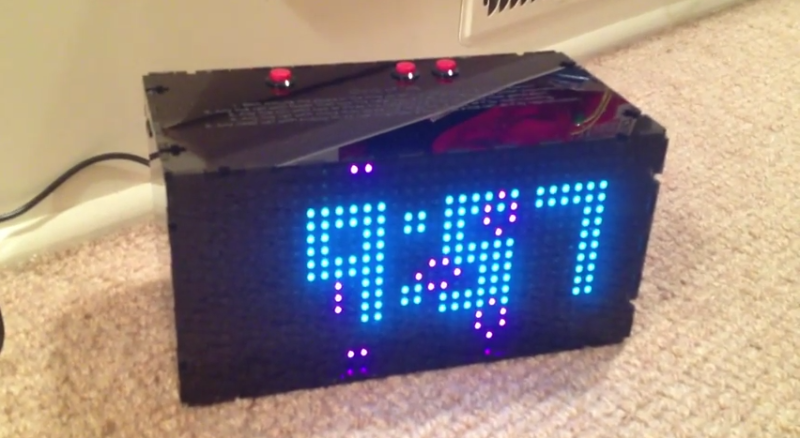[Matthews] needed a good present to give to his brother-in-law, who just so happens to be a mathematician and programmer. He wanted something functional but equally geeky at the same time, so he decided to try his hand at making a Game of Life style clock.
He was originally inspired by a Game of Life Clock we shared a few months ago, but with a few improvements. First, he wanted a much bigger playing field, so he found a 16×32 RGB LED matrix. Second, he wanted the time to always be visible so it actually works as a functional clock.
At the heart of the device is an Arduino UNO which utilizes a Chronodot RTC module for accurate time keeping. The entire clock is encased in acrylic sheets and it looks extremely good for a home-made project. He designed the case using a site called MakerCase, which is a super handy application for designing boxes.
At the beginning of every minute starts a new Game of Life which plays over top of the time displayed. Three buttons on the top allow for many adjustments including brightness, timezone, speed, colors, and even edge behavior! To see it in action, stick around after the break.
















This is extremely neat!
NIce! What kind of acrylic is that?
Cut from cast acrylic sheets I got off amazon. Transparent gray for the frontandtranslucentblackfor everything else. The acrylic in front of the matrix drastically improved the look of it.
http://www.amazon.com/Cast-Acrylic-Sheet-Thick-Thickness/dp/B004N1JLI4
http://www.thingiverse.com/thing:404
Box-o-tron. Python, not web based but more versatile.
I will look into box-o-tron for my next one. The case was my biggest problem, and the slots for the nuts on this case came out way to large so i had to endupgluingthe whole thing.
I’m the creator of MakerCase. Sorry you had problems with your plans. If you message me here or via the app with the details, I’ll look at revising the template in my next revision.
Cool thing, how much it cost?
This one cost me about $120, although when I make the next one for myself I think I can do it considerably cheaper. Sparkfun just started selling the LED panels for quite a bit less than adafruit
This is awesome! I would love to have a crack at making one of these. Is the source code available?
I haven’t released any source for this yet, although if you are interested send me a comment on blog linked in the article and I can do a little cleanup on it and send it over.
What about not resetting the display every minute, but merely introducing the changed digits to the life map?
Conway’s rules tend to settle into still forms and simple oscillators. There are lots of other rules, including dozens of interesting ones just involving changing the life / death thresholds. Some of those might be more visually interesting. Brain gives lots of “space ships”, zooming along and breaking off into new ones.
I like Andy’s idea too, having the numbers dissolve into chaos as they’re put up each minute. Might make it less practical as a clock, perhaps keep a small constant time display in one corner. Or have it as an option at least.
I didn’t mean remove the blue digits. It just seemed to me that resetting the display was to avoid static or oscillating sequences. But it’s a little jarring. A new digit should be enough to restart a dynamic display.
Ah, I assumed the digits were taken into account, but looking at the Hive pattern there, looks like they aren’t. So yeah your idea’s good, even one changed digit might give you a minute’s worth of changes.
I personally like having the display wiped and reset each minute — while it was sitting around my house in various stages of completion for the month of december, both my wife and I enjoyed watching it and finding our favorite “minutes”, as each one would completely unique. Also with the medium speed, you are only getting a few hundred generations of the game each minute, so most of them didn’t decompose into still lifes and oscillators til near the very end of the minute. Some parts of the day were a little boring (1:11 for example) due to the limited number of starting pixels.
Not to say that I couldn’t easily add that in as an option on the next version. As I’ve already given this one away, I can’t make anymore changes to it!
excellent
Still loving this clock, despite the suggested (arguable) improvements.